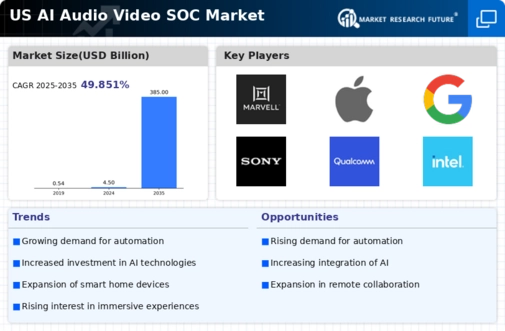Emergence of 5G Technology
The rollout of 5G technology is poised to revolutionize the ai audio-video-soc market. With its promise of ultra-fast data transfer speeds and low latency, 5G enables high-definition streaming and real-time content delivery, which are essential for modern audio and video applications. By 2025, it is expected that 5G subscriptions will surpass 1 billion globally, significantly impacting the US market. This technological advancement allows for more immersive experiences, such as augmented and virtual reality applications, which rely heavily on high-quality audio and video. The ai audio-video-soc market stands to gain from this shift, as companies invest in developing solutions that leverage 5G capabilities to enhance user experiences and expand their service offerings.
Advancements in AI Technology
Technological advancements in AI are reshaping the landscape of the ai audio-video-soc market. Innovations in machine learning, natural language processing, and computer vision are enabling more sophisticated audio and video processing capabilities. For instance, AI algorithms can now analyze user preferences and adapt content accordingly, enhancing viewer engagement. The market for AI in audio and video applications is expected to grow at a CAGR of around 25% through 2025, reflecting the increasing reliance on AI-driven solutions. This growth is indicative of a broader trend where the ai audio-video-soc market is becoming increasingly intertwined with cutting-edge AI technologies, leading to enhanced product offerings and improved operational efficiencies.
Rise of Smart Home Technologies
The proliferation of smart home technologies is significantly influencing the ai audio-video-soc market. As more households adopt smart devices, the demand for integrated audio and video solutions that can seamlessly interact with these devices is on the rise. In 2025, the smart home market is anticipated to exceed $150 billion, creating a substantial opportunity for the ai audio-video-soc market. This trend suggests that manufacturers must focus on developing AI-enabled audio-video solutions that can communicate effectively with various smart home ecosystems. The integration of AI not only enhances user convenience but also improves energy efficiency and security, making it a critical factor in the evolution of home entertainment systems.
Increased Focus on Content Security
As digital content consumption rises, so does the need for robust security measures within the ai audio-video-soc market. Content creators and distributors are increasingly concerned about piracy and unauthorized access to their materials. The market for content security solutions is projected to grow significantly, with estimates suggesting a value of over $10 billion by 2025. This heightened focus on security drives the demand for AI technologies that can provide advanced encryption and authentication methods. The ai audio-video-soc market must adapt to these security challenges by incorporating AI-driven solutions that ensure content protection while maintaining user accessibility. This dual focus on security and usability is likely to shape the future of audio and video technologies.
Growing Demand for Streaming Services
The increasing popularity of streaming services in the US is a primary driver for the ai audio-video-soc market. As consumers shift from traditional cable to on-demand content, the need for advanced audio and video processing technologies becomes evident. In 2025, the streaming market is projected to reach approximately $100 billion, indicating a robust growth trajectory. This surge necessitates the integration of AI technologies to enhance user experience, optimize content delivery, and improve personalization. The ai audio-video-soc market is thus positioned to benefit significantly from this trend, as companies seek to leverage AI for better content management and distribution. Furthermore, the demand for high-quality audio and video experiences is likely to drive innovation in semiconductor technologies, further propelling the market forward.






















Leave a Comment